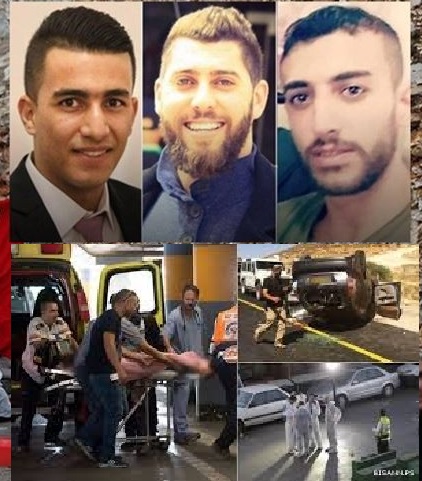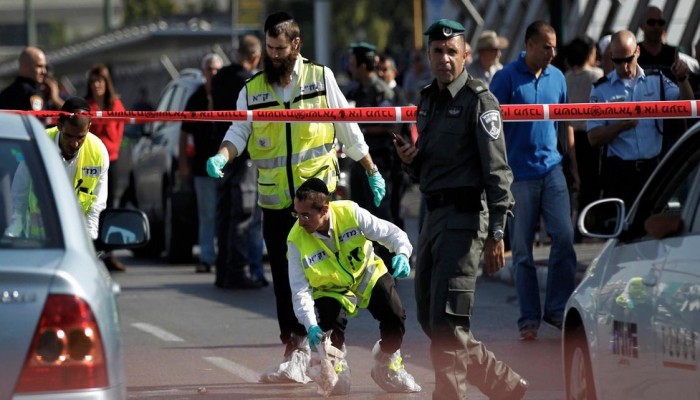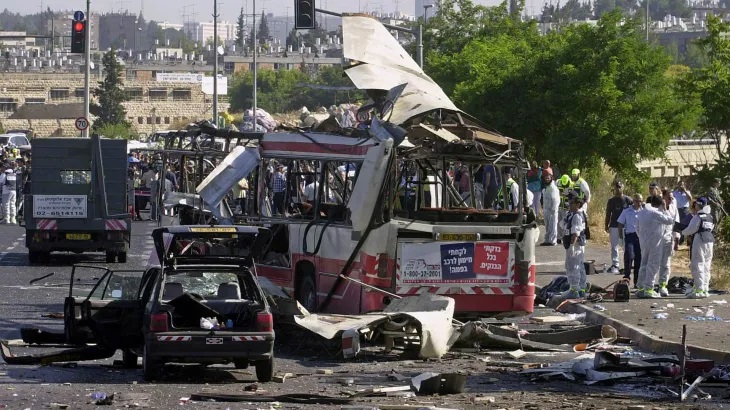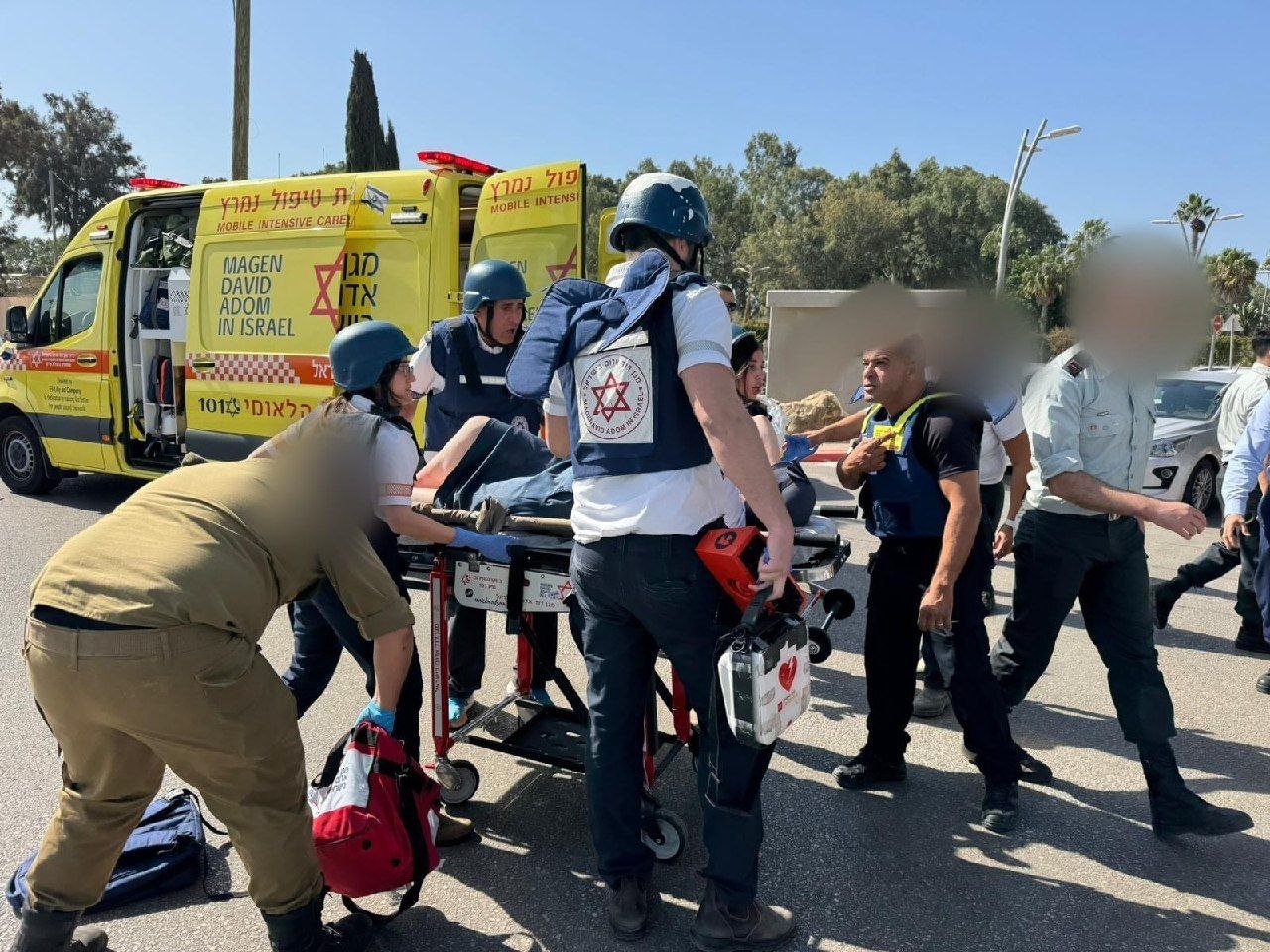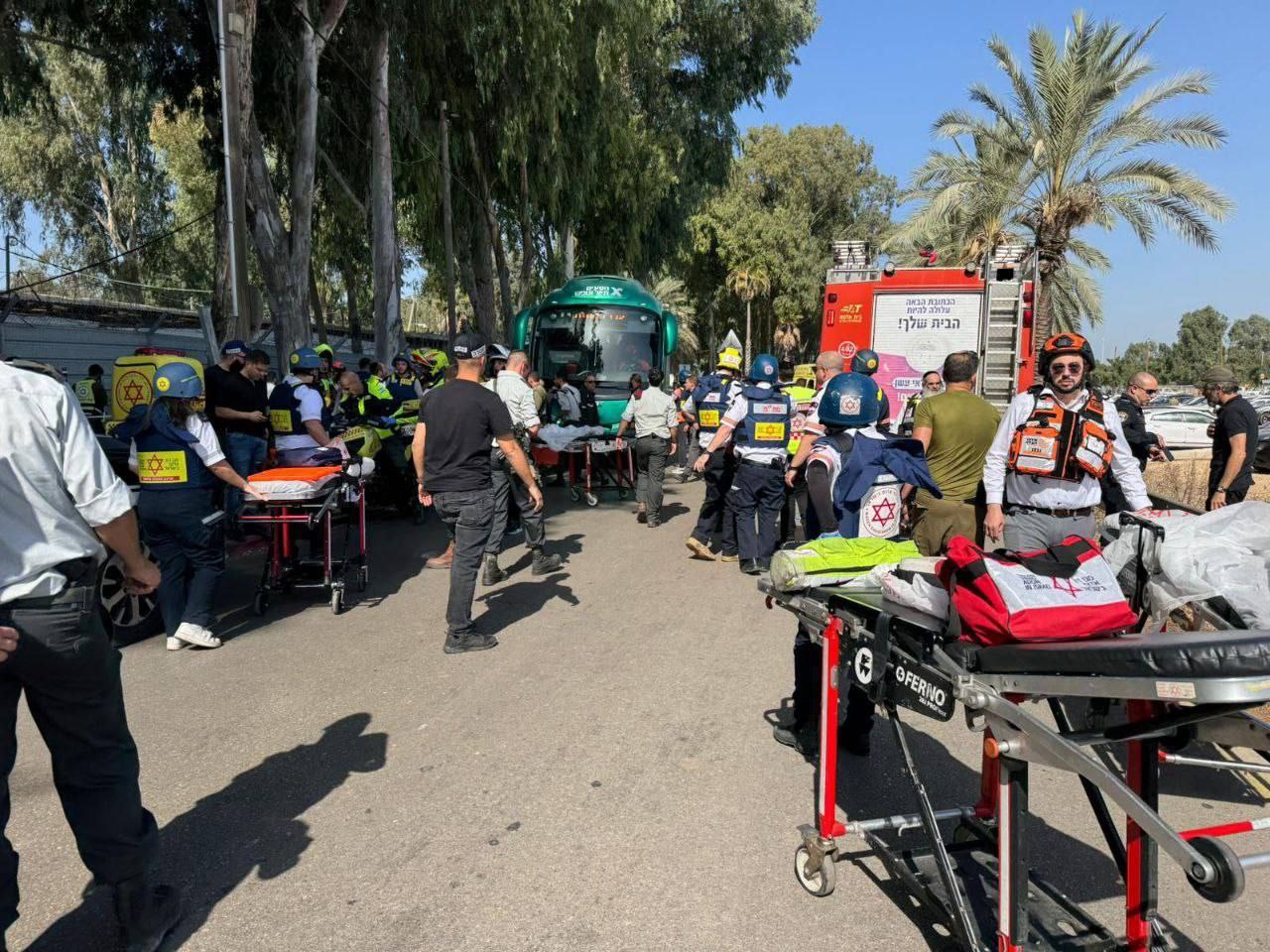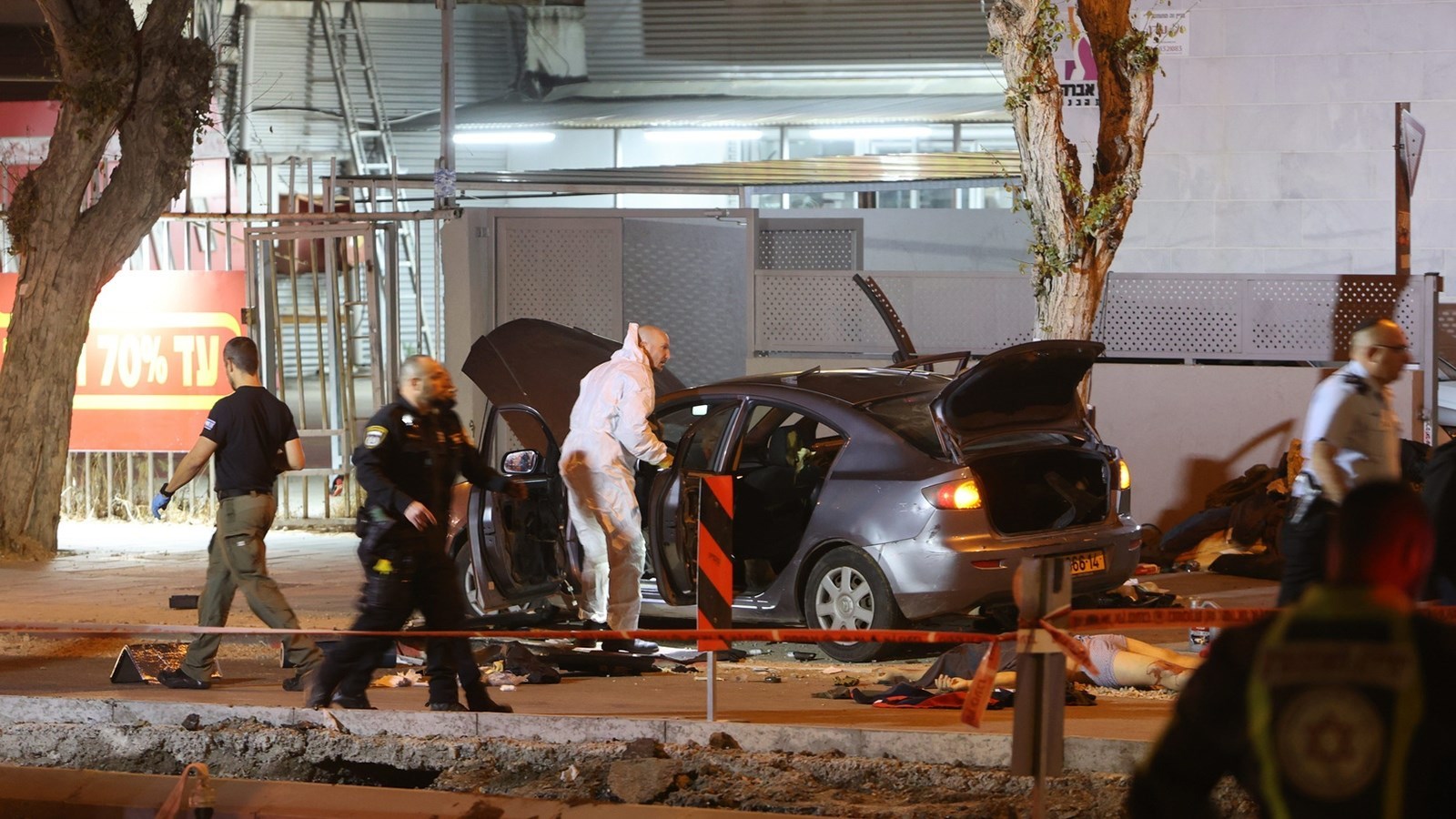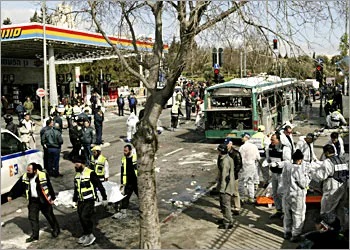
Sana'a - Saba:
Day by day, Palestinian Commando operations are escalating deep within the heart of the Zionist entity, creating a nightmare that disrupts the enemy's calculations, undermines its intelligence efforts, and exposes its security vulnerabilities.
In this context, the West Bank, including occupied al-Quds, has seen a surge in resistance operations against the Zionist soldiers and settler groups. These actions have resulted in the deaths and injuries of dozens of them, encompassing various tactics such as shooting, vehicle ramming, and stabbing. Since the onset of the genocidal war on Gaza, these operations have led to the deaths of at least 50 Zionists.
The heroic ramming operation near the Zionist military base "Glilot," north of Tel Aviv, on Sunday stands out as one of the most significant actions since the commencement of the extermination war on Gaza on October 7, 2023. This operation not only resulted in the deaths of six Zionist soldiers and injuries to 50 others but also took place in a strategic location near a military base housing key intelligence operations, including those of Mossad and the "Unit 8200" military intelligence division.
Hours after the ramming incident, in which a Palestinian driver deliberately crashed his truck into a crowd at a bus stop in Glilot, the Zionist police reported another attempted ramming targeting soldiers near the village of Hizma in the occupied West Bank.
This type of heroic, uncoordinated individual operation is not limited to guerrilla tactics; it also manifests in the Palestinian resistance's responses to incursions by the Zionist army into occupied territories. Resistance fighters have been preparing homemade explosive devices and employing various means of retaliation.
According to official Palestinian statistics, during September, the occupied West Bank experienced 168 shootings, along with four ramming and stabbing attacks, and 130 incidents involving the throwing of Molotov cocktails targeting Zionist soldiers in various areas.
The Palestine Information Center (Maata) reports that since the onset of the war on Gaza, there have been 63 significant operations, including 23 ramming attacks and 40 stabbing incidents, alongside 1,840 shooting operations. These actions have resulted in the deaths of 50 soldiers and Zionist settlers, with 379 others injured.
The Zionist army recently reported the outcome of missile and rocket launches directed at the usurping entity since the war began on October 7, stating that "Israel" has faced "more than 26,000 launches," without detailing the types or quantities of the missiles involved.
According to their statement, the breakdown includes: 13,200 rockets fired from the Gaza Strip, 12,400 from Lebanon, 400 from Iran, 180 from Yemen, and 60 from Syria.
The individual operations carried out by Palestinian youths represent a bold challenge to the Zionist entity, which, despite its brutal tactics against Palestinians, seeks to deter such actions. However, the violent practices of its army and the massacres committed in the Gaza Strip over the past year have only served to fuel these operations.
With the shift in the Zionist political and security landscape following "al-Aqsa Flood" operation, individual guerrilla operations have surged, heightening security concerns regarding a potential return of martyrdom operations targeting the Zionist rear, including commercial markets, buses, and entertainment centers. This concern intensified after the truck bombing in Tel Aviv on August 18, which involved an explosive device claimed by al-Qassam Brigades, the military wing of Hamas.
On another front, Jihadist operations along the longer eastern borders with the Zionist entity have emerged through individual actions initiated by Jordanian youths. Notable incidents include the operation at Karama crossing carried out by martyr Maher al-Jazi on September 8, and the Dead Sea operation on October 18, executed by martyrs Hussam Abu Ghazaleh and Amer Qawas. These actions follow "al-Aqsa Flood" operation and reflect a strategy of opening new fronts, which has raised significant security concerns among the Zionist authorities.
In a speech commemorating the noble birth of the Prophet, the leader of the revolution, Mr. Abdulmalik bin Badr al-Din al-Houthi, praised the jihadist commando operation carried out by Jordanian martyr Maher al-Jazi. He described this heroic operation as impressive and deeply unsettling for the Zionist enemy.
Al-Houthi emphasized that the action of martyr al-Jazi demonstrates that there are still individuals within the Jordanian populace who remain sincerely committed to the cause of Palestine. He noted that while al-Jazi's operation was executed individually and with simple weaponry, it had a significant impact on the Zionist entity.
The new deterrence new appears to be a consequence of the Palestinian resistance's actions following the martyrdom operation in Tel Aviv, which strikes at the core of Zionist security and the personal safety of each settler, rendering them vulnerable to attacks anywhere, at any time. This has restored a crucial balance of deterrence during this sensitive period.
Observers believe that, regardless of the specific circumstances and details of these operations, they signify an exceptional shift, foreshadowing a resurgence of guerrilla actions in the heart of occupied cities. This scenario is a cause for concern for the Zionist security and intelligence apparatus, potentially bringing settlers back to a state of fear reminiscent of previous years, particularly in cities like Tel Aviv that they once considered safe.
Hamas movement launched this kind of operations systematically for the first time in response to the massacre of Haram al-Ibrahimi al-Sharif on February 25, 1994, which was carried out by a member of the extremist Kach movement, the extremist settler Baruch Goldstein, who opened fire on Palestinian worshippers during dawn prayers inside the Ibrahimi Mosque in Hebron in the south of the West Bank, resulting in 29 martyrs and more than 125 wounded.
In response to this massacre, Hamas carried out its first "fedayeen" operation in Tel Aviv on October 19, 1994 by blowing up a bus on Dizengoff Street, killing more than 20 Zionists and injuring 104 others.
By the end of the nineties of the last century, the movement expanded the scope of its "fedayeen" action in protest against the Oslo agreement signed between the Zionist entity and the Palestine Liberation Organization.
At that time, the operations became the main weapon of all the main Palestinian factions and actors on the scene. The frequency of "fedayeen" operations increased between 2000 and 2005, from all Palestinian factions, to reach 135 operations, of which Hamas alone accounted for 54 operations, about 40 percent.
But with the change of the political and security scene after "Al-Aqsa flood", the "Fedayeen" operations returned as an option on the table again, with the continuation of the Zionist genocidal war against the Gaza Strip for almost a whole year, and the increasing pressure in the occupied West Bank and al-Quds.
The usurping entity witnessed a number of qualitative operations adopted by the Palestinian resistance factions since the Second Intifada; the most severe of which occurred at the beginning of the third millennium.
These are the most prominent operations since 2000: - The death of 21 Zionists in an operation at a nightclub on the beach of "Tel Aviv" on the first of June 2001.-
The death of 23 Zionists by the bombing of the Central Bus Station in the center of "Tel Aviv" on the fifth of January 2003. – 24 Zionists were killed after a young man blew himself up on a bus in al-Quds on August 19, 2003.
The death of 21 Zionists in an operation of the jihad movement in a restaurant in Haifa on the Fourth of October 2003. – 16 Zionists were killed in a double attack at the meeting of two bus lines in Beersheba on August 31, 2004.-
11 Zionists were killed in a bombing at a restaurant in "Tel Aviv" on April 17, 2006.- Three Zionists were killed in an explosion at a bakery in Eilat in the northern Gaza Strip on January 29, 2007.
20 Zionists were injured by the explosion of an explosive device on a bus in al-Quds on April 18, 2016.The data of the Zionist general security service "Shin Bet" revealed the rise of Palestinian operations against the occupation army and settlers in 2022, which caused great concern to the security services of the usurping entity.
The Shin Bet pointed out that "1,570 operations took place in the West Bank in 2021, in which 18 Israeli settlers were killed and 196 others were injured inside Israel and in the West Bank".. "As for the year 2022, 1933 operations took place in the West Bank; an increase of 363, which led to the death of 29 soldiers and Zionist settlers (in another statistic, the enemy admitted the death of 31 Zionists) killed this year in Palestinian operations and wounded about 128 others,"he said.
Day by day, Palestinian Commando operations are escalating deep within the heart of the Zionist entity, creating a nightmare that disrupts the enemy's calculations, undermines its intelligence efforts, and exposes its security vulnerabilities.
In this context, the West Bank, including occupied al-Quds, has seen a surge in resistance operations against the Zionist soldiers and settler groups. These actions have resulted in the deaths and injuries of dozens of them, encompassing various tactics such as shooting, vehicle ramming, and stabbing. Since the onset of the genocidal war on Gaza, these operations have led to the deaths of at least 50 Zionists.
The heroic ramming operation near the Zionist military base "Glilot," north of Tel Aviv, on Sunday stands out as one of the most significant actions since the commencement of the extermination war on Gaza on October 7, 2023. This operation not only resulted in the deaths of six Zionist soldiers and injuries to 50 others but also took place in a strategic location near a military base housing key intelligence operations, including those of Mossad and the "Unit 8200" military intelligence division.
Hours after the ramming incident, in which a Palestinian driver deliberately crashed his truck into a crowd at a bus stop in Glilot, the Zionist police reported another attempted ramming targeting soldiers near the village of Hizma in the occupied West Bank.
This type of heroic, uncoordinated individual operation is not limited to guerrilla tactics; it also manifests in the Palestinian resistance's responses to incursions by the Zionist army into occupied territories. Resistance fighters have been preparing homemade explosive devices and employing various means of retaliation.
According to official Palestinian statistics, during September, the occupied West Bank experienced 168 shootings, along with four ramming and stabbing attacks, and 130 incidents involving the throwing of Molotov cocktails targeting Zionist soldiers in various areas.
The Palestine Information Center (Maata) reports that since the onset of the war on Gaza, there have been 63 significant operations, including 23 ramming attacks and 40 stabbing incidents, alongside 1,840 shooting operations. These actions have resulted in the deaths of 50 soldiers and Zionist settlers, with 379 others injured.
The Zionist army recently reported the outcome of missile and rocket launches directed at the usurping entity since the war began on October 7, stating that "Israel" has faced "more than 26,000 launches," without detailing the types or quantities of the missiles involved.
According to their statement, the breakdown includes: 13,200 rockets fired from the Gaza Strip, 12,400 from Lebanon, 400 from Iran, 180 from Yemen, and 60 from Syria.
The individual operations carried out by Palestinian youths represent a bold challenge to the Zionist entity, which, despite its brutal tactics against Palestinians, seeks to deter such actions. However, the violent practices of its army and the massacres committed in the Gaza Strip over the past year have only served to fuel these operations.
With the shift in the Zionist political and security landscape following "al-Aqsa Flood" operation, individual guerrilla operations have surged, heightening security concerns regarding a potential return of martyrdom operations targeting the Zionist rear, including commercial markets, buses, and entertainment centers. This concern intensified after the truck bombing in Tel Aviv on August 18, which involved an explosive device claimed by al-Qassam Brigades, the military wing of Hamas.
On another front, Jihadist operations along the longer eastern borders with the Zionist entity have emerged through individual actions initiated by Jordanian youths. Notable incidents include the operation at Karama crossing carried out by martyr Maher al-Jazi on September 8, and the Dead Sea operation on October 18, executed by martyrs Hussam Abu Ghazaleh and Amer Qawas. These actions follow "al-Aqsa Flood" operation and reflect a strategy of opening new fronts, which has raised significant security concerns among the Zionist authorities.
In a speech commemorating the noble birth of the Prophet, the leader of the revolution, Mr. Abdulmalik bin Badr al-Din al-Houthi, praised the jihadist commando operation carried out by Jordanian martyr Maher al-Jazi. He described this heroic operation as impressive and deeply unsettling for the Zionist enemy.
Al-Houthi emphasized that the action of martyr al-Jazi demonstrates that there are still individuals within the Jordanian populace who remain sincerely committed to the cause of Palestine. He noted that while al-Jazi's operation was executed individually and with simple weaponry, it had a significant impact on the Zionist entity.
The new deterrence new appears to be a consequence of the Palestinian resistance's actions following the martyrdom operation in Tel Aviv, which strikes at the core of Zionist security and the personal safety of each settler, rendering them vulnerable to attacks anywhere, at any time. This has restored a crucial balance of deterrence during this sensitive period.
Observers believe that, regardless of the specific circumstances and details of these operations, they signify an exceptional shift, foreshadowing a resurgence of guerrilla actions in the heart of occupied cities. This scenario is a cause for concern for the Zionist security and intelligence apparatus, potentially bringing settlers back to a state of fear reminiscent of previous years, particularly in cities like Tel Aviv that they once considered safe.
Hamas movement launched this kind of operations systematically for the first time in response to the massacre of Haram al-Ibrahimi al-Sharif on February 25, 1994, which was carried out by a member of the extremist Kach movement, the extremist settler Baruch Goldstein, who opened fire on Palestinian worshippers during dawn prayers inside the Ibrahimi Mosque in Hebron in the south of the West Bank, resulting in 29 martyrs and more than 125 wounded.
In response to this massacre, Hamas carried out its first "fedayeen" operation in Tel Aviv on October 19, 1994 by blowing up a bus on Dizengoff Street, killing more than 20 Zionists and injuring 104 others.
By the end of the nineties of the last century, the movement expanded the scope of its "fedayeen" action in protest against the Oslo agreement signed between the Zionist entity and the Palestine Liberation Organization.
At that time, the operations became the main weapon of all the main Palestinian factions and actors on the scene. The frequency of "fedayeen" operations increased between 2000 and 2005, from all Palestinian factions, to reach 135 operations, of which Hamas alone accounted for 54 operations, about 40 percent.
But with the change of the political and security scene after "Al-Aqsa flood", the "Fedayeen" operations returned as an option on the table again, with the continuation of the Zionist genocidal war against the Gaza Strip for almost a whole year, and the increasing pressure in the occupied West Bank and al-Quds.
The usurping entity witnessed a number of qualitative operations adopted by the Palestinian resistance factions since the Second Intifada; the most severe of which occurred at the beginning of the third millennium.
These are the most prominent operations since 2000: - The death of 21 Zionists in an operation at a nightclub on the beach of "Tel Aviv" on the first of June 2001.-
The death of 23 Zionists by the bombing of the Central Bus Station in the center of "Tel Aviv" on the fifth of January 2003. – 24 Zionists were killed after a young man blew himself up on a bus in al-Quds on August 19, 2003.
The death of 21 Zionists in an operation of the jihad movement in a restaurant in Haifa on the Fourth of October 2003. – 16 Zionists were killed in a double attack at the meeting of two bus lines in Beersheba on August 31, 2004.-
11 Zionists were killed in a bombing at a restaurant in "Tel Aviv" on April 17, 2006.- Three Zionists were killed in an explosion at a bakery in Eilat in the northern Gaza Strip on January 29, 2007.
20 Zionists were injured by the explosion of an explosive device on a bus in al-Quds on April 18, 2016.The data of the Zionist general security service "Shin Bet" revealed the rise of Palestinian operations against the occupation army and settlers in 2022, which caused great concern to the security services of the usurping entity.
The Shin Bet pointed out that "1,570 operations took place in the West Bank in 2021, in which 18 Israeli settlers were killed and 196 others were injured inside Israel and in the West Bank".. "As for the year 2022, 1933 operations took place in the West Bank; an increase of 363, which led to the death of 29 soldiers and Zionist settlers (in another statistic, the enemy admitted the death of 31 Zionists) killed this year in Palestinian operations and wounded about 128 others,"he said.
